ECO mode Citroen DS5 HYBRID 2016 1.G User Guide
[x] Cancel search | Manufacturer: CITROEN, Model Year: 2016, Model line: DS5 HYBRID, Model: Citroen DS5 HYBRID 2016 1.GPages: 376, PDF Size: 12.57 MB
Page 105 of 376
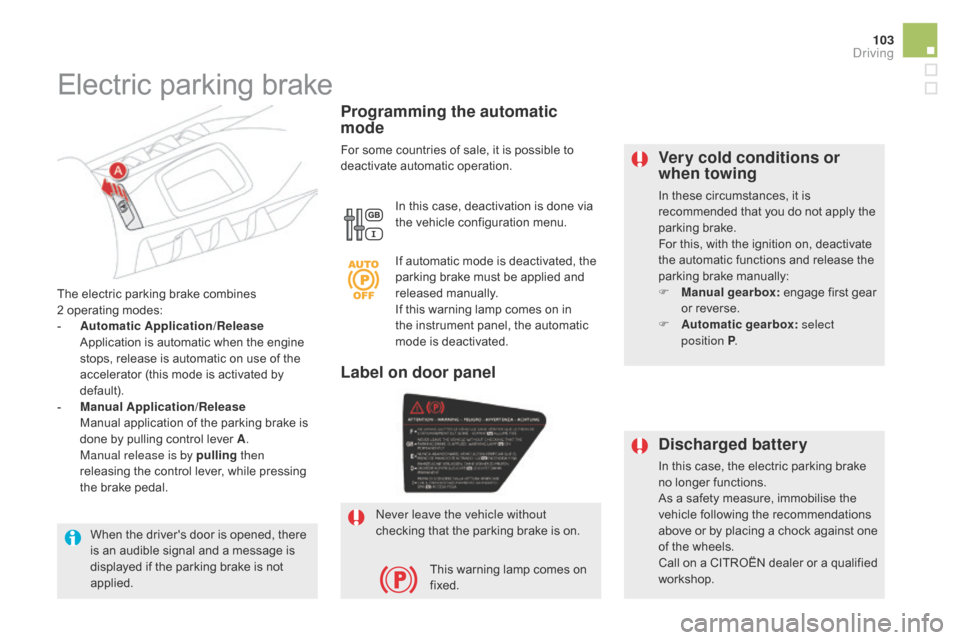
103
DS5_en_Chap04_conduite_ed02-2015
very cold conditions or
wh en towing
In these circumstances, it is
recommended that you do not apply the
parking brake.
For this, with the ignition on, deactivate
the automatic functions and release the
parking brake manually:
F
Ma
nual gearbox: engage first gear
or reverse.
F
Au
tomatic gearbox: select
position P .
The electric parking brake combines
2
o
perating modes:
-
Au
tomatic Application/Release
Ap
plication is automatic when the engine
stops, release is automatic on use of the
accelerator (this mode is activated by
default).
-
Ma
nual Application/Release
Ma
nual application of the parking brake is
done by pulling control lever A .
Ma
nual release is by pulling then
releasing the control lever, while pressing
the brake pedal.
Programming the automatic
mode
For some countries of sale, it is possible to
deactivate automatic operation.
In this case, deactivation is done via
the vehicle configuration menu.
Electric parking brake
If automatic mode is deactivated, the
parking brake must be applied and
released manually.
If this warning lamp comes on in
the instrument panel, the automatic
mode is deactivated.
Never leave the vehicle without
checking that the parking brake is on. This warning lamp comes on
fixed.
Label on door panel
dis
charged battery
In this case, the electric parking brake
no longer functions.
As a safety measure, immobilise the
vehicle following the recommendations
above or by placing a chock against one
of the wheels.
Call on a CITROËN dealer or a qualified
workshop.
When the driver's door is opened, there
is an audible signal and a message is
displayed if the parking brake is not
applied.
driving
Page 115 of 376

11 3
DS5_en_Chap04_conduite_ed02-2015
Manual operation
F Select position M for sequential changing
of the six gears.
F
Pu
sh the selector towards the + sign to
change up a gear.
F
Pu
ll the selector towards the - sign to
change down a gear.
It is only possible to change from one gear to
another if the vehicle speed and engine speed
permit; other wise, the gearbox will operate
temporarily in automatic mode.
d d
isappears and the gears engaged
appear in succession on the
instrument panel.
If the engine speed is too low or too high, the
gear selected flashes for a few seconds, then
the actual gear engaged is displayed.
When the vehicle is stationary or moving
very slowly, the gearbox selects gear 1
automatically.
It is not necessary to release the accelerator
when changing gear.
It is possible to change from position
d
(
automatic) to position M (manual) at any time.
The sport and snow programmes do not
operate in manual mode.
Sport and snow programmes
Sport programme "S"
F Press button "S" , a fter starting the engine.
The gearbox automatically favours a dynamic
style of driving.
S appears in the instrument panel.
Snow programme " T"
F Press button " T" , after starting the engine.
The gearbox adapts to driving on slippery
roads.
This programme improves starting and drive
when traction is poor.
T appears in the instrument panel.
Return to auto-adaptive
mode
F At any time, press the button selected
again to leave the special programme
engaged and return to auto-adaptive mode.
These two special programmes supplement the
automatic operation in very specific conditions
of use.
driving
Page 116 of 376

DS5_en_Chap04_conduite_ed02-2015
Invalid value during manual
operation
This symbol is displayed if a gear
is not engaged correctly (selector
between two positions).
Stopping the vehicle
Before switching off the engine, put the selector
in position P or N to place the gearbox in
neutral.
In both cases, apply the parking brake to
immobilise the vehicle, unless it is programmed
to automatic mode.If the selector is not in position P ,
when the driver's door is opened or
approximately 45 seconds after the
ignition is switched off, there is an
audible signal and a message appears.
F
Re
turn the selector to position P ;
the audible signal stops and the
message disappears.
Operating fault
When the ignition is on, a message appears
in the instrument panel screen to indicate a
gearbox fault.
In this case, the gearbox switches to back-up
mode and is locked in 3rd gear. You may feel
a substantial knock when changing from P
to R and from N to R . This will not cause any
damage to the gearbox.
Do not exceed 60 mph (100 km/h), local speed
restrictions permitting.
Have it checked by a CITROËN dealer or a
qualified workshop. You risk damaging the gearbox:
-
if y
ou press the accelerator and
brake pedals at the same time,
-
if y
ou force the selector from
position P to another position when
the battery is flat.
To reduce fuel consumption when
stationary for long periods with the
engine running (traffic jam...), position
the gear selector at N and apply the
parking brake, unless it is programmed
in automatic mode.
Page 117 of 376
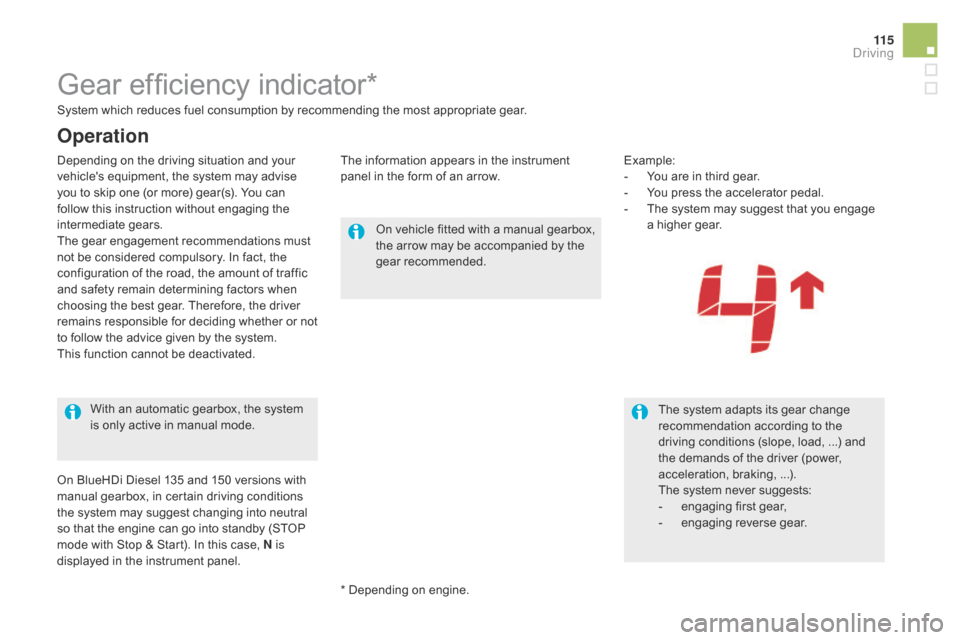
11 5
DS5_en_Chap04_conduite_ed02-2015
Gear efficiency indicator*
On vehicle fitted with a manual gearbox,
the arrow may be accompanied by the
gear recommended.The system adapts its gear change
recommendation according to the
driving conditions (slope, load, ...) and
the demands of the driver (power,
acceleration, braking, ...).
The system never suggests:
-
en
gaging first gear,
-
engag
ing reverse gear.
With an automatic gearbox, the system
is only active in manual mode.
* Depending on engine.
On BlueHDi Diesel 135 and 150 versions with
manual gearbox, in certain driving conditions
the system may suggest changing into neutral
so that the engine can go into standby (STOP
mode with Stop & Start). In this case, N is
displayed in the instrument panel. System which reduces fuel consumption by recommending the most appropriate gear.
Operation
Depending on the driving situation and your
vehicle's equipment, the system may advise
you to skip one (or more) gear(s). You can
follow this instruction without engaging the
intermediate gears.
The gear engagement recommendations must
not be considered compulsory. In fact, the
configuration of the road, the amount of traffic
and safety remain determining factors when
choosing the best gear. Therefore, the driver
remains responsible for deciding whether or not
to follow the advice given by the system.
This function cannot be deactivated. Example:
- Yo
u are in third gear.
-
Yo
u press the accelerator pedal.
-
Th
e system may suggest that you engage
a higher gear.
The information appears in the instrument
panel in the form of an arrow.
driving
Page 120 of 376

DS5_en_Chap04_conduite_ed02-2015
Stop & Start
Operation
Going into engine STOP mode
The "EcO" w arning lamp comes on
in the instrument panel and the engine
goes into standby automatically:
-
wi
th a manual gearbox , at speeds below
12 mph (20 km/h) or vehicle stationary with
the THP 120 petrol and BlueHDi 115 and
120 Diesel versions, when you place the
gear lever in neutral and you release the
clutch pedal,
-
wi
th an automatic gearbox , vehicle
stationary, when you press the brake pedal
or put the gear selector in position N .If your vehicle is fitted with the
system, a time counter calculates
the sum of the periods in STOP
mode during a journey. It resets itself
to zero every time the ignition is
switched on with the START/STOP
button.
Never refuel with the engine in STOP
mode; you must switch off the ignition
with the START/STOP button.
For your comfort, during parking
maoeuvres, STOP mode is not
available for a few seconds after
coming out of reverse gear.
Stop & Start does not affect the
operation of vehicle systems such as
braking, power steering...
The Stop & Start
s
ystem puts the engine temporarily into standby - STOP mode - during stops in the traffic (red lights, traffic jams, ...). The engine
restarts automatically - START mode - as soon as you want to move off. The restart takes place instantly, quickly and silently.
Per fect for urban use, the Stop & Start system reduces fuel consumption and exhaust emissions as well as the noise level when stationary.
Page 121 of 376

11 9
DS5_en_Chap04_conduite_ed02-2015
Special cases: STOP mode not
available
STOP mode is not invoked when:
- the vehicle is on a steep slop (rising or
falling),
-
th
e driver's door is open,
-
th
e driver's seat belt is not fastened,
-
th
e vehicle has not exceeded 6 mph
(10
k
m/h) since the last engine start using
the START/STOP button,
-
th
e electric parking brake is applied or
being applied,
-
th
e engine is needed to maintain a
comfortable temperature in the passenger
compartment,
-
de
misting is active,
-
so
me special conditions (battery charge,
engine temperature, braking assistance,
ambient temperature...) where the engine is
needed to assure control of a system.
In this case, the "E
cO" w
arning lamp
flashes for a few seconds then
goes off.
This operation is perfectly normal.
Going into engine START mode
The "EcO" w arning lamp goes off
and the engine starts automatically:
-
wi
th a manual gearbox , when you fully
depress the clutch pedal,
-
wi
th an automatic gearbox :
●
ge
ar selector in position
d o
r M, when
you release the brake pedal,
●
or g
ear selector in position N and brake
pedal released, when you place the gear
selector in position
d o
r M,
●
or w
hen you engage reverse. As a safety measure or to maintain comfort
levels in the vehicle, START mode is invoked
automatically when:
-
yo
u open the driver's door,
-
yo
u unfasten the driver's seat belt,
-
th
e speed of the vehicle exceeds 15
m
ph
(25 km/h) with a manual gearbox (2
m
ph
(3
k
m/h) with THP 210 petrol and
BlueHDi
1
15 and 120 Diesel versions), or
2
m
ph (3
k
m/h) with an automatic gearbox,
-
th
e electric parking brake is being applied,
-
so
me special conditions (battery charge,
engine temperature, braking assistance,
ambient temperature...) where the engine is
needed for control of a system.
Special cases: START invoked
automatically
In this case the "EcO" w arning lamp
flashes for a few seconds, then
goes off.
This operation is perfectly normal.
driving
Page 122 of 376
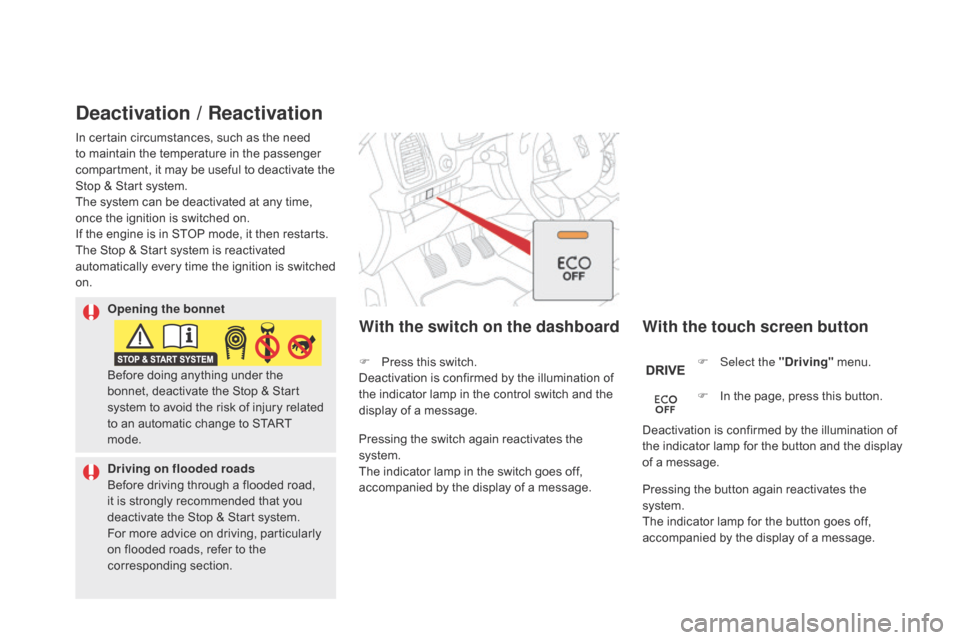
DS5_en_Chap04_conduite_ed02-2015
deactivation / Reactivation
With the touch screen button
With the switch on the dashboard
F Select the "dri ving" menu.
F
In t
he page, press this button.
Deactivation is confirmed by the illumination of
the indicator lamp for the button and the display
of a message.
Pressing the switch again reactivates the
system.
The indicator lamp in the switch goes off,
accompanied by the display of a message. F Pr
ess this switch.
Deactivation is confirmed by the illumination of
the indicator lamp in the control switch and the
display of a message.
Pressing the button again reactivates the
system.
The indicator lamp for the button goes off,
accompanied by the display of a message.
Opening the bonnet
dri
ving on flooded roads
Before driving through a flooded road,
it is strongly recommended that you
deactivate the Stop & Start system.
For more advice on driving, particularly
on flooded roads, refer to the
corresponding section.
In certain circumstances, such as the need
to maintain the temperature in the passenger
compartment, it may be useful to deactivate the
Stop & Start system.
The system can be deactivated at any time,
once the ignition is switched on.
If the engine is in STOP mode, it then restarts.
The Stop & Start system is reactivated
automatically every time the ignition is switched
on.
Before doing anything under the
bonnet, deactivate the Stop & Start
system to avoid the risk of injury related
to an automatic change to START
mode.
Page 129 of 376
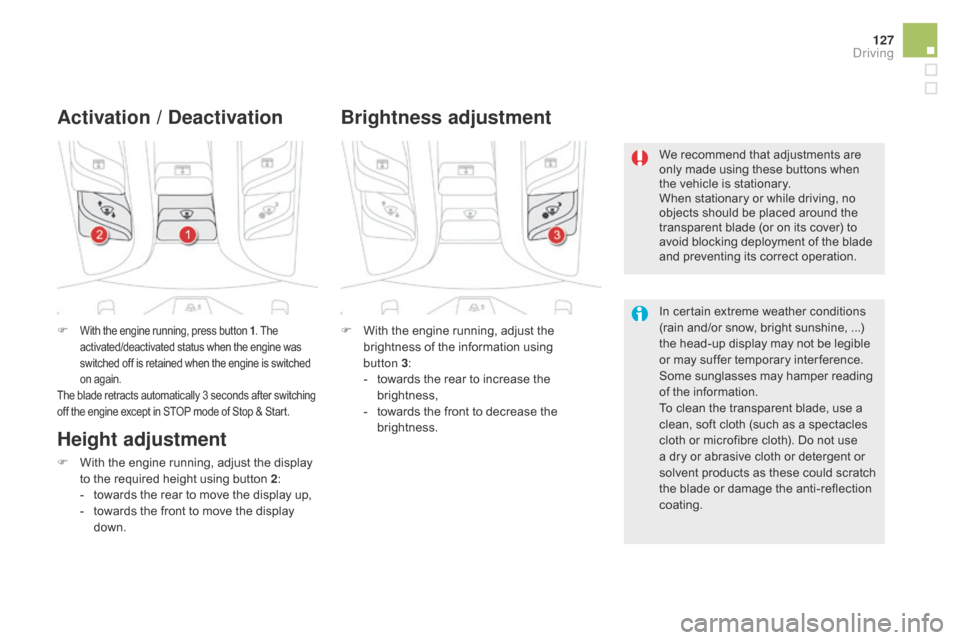
127
DS5_en_Chap04_conduite_ed02-2015
F With the engine running, press button 1. The
activated/deactivated status when the engine was
switched off is retained when the engine is switched
on again.
The blade retracts automatically 3 seconds after switching
off the engine except in STOP mode of Stop & Start.
Activation / dea ctivation
F With the engine running, adjust the
b
rightness of the information using
button
3 :
- to
wards the rear to increase the
brightness,
-
to
wards the front to decrease the
brightness.
Brightness adjustment
We recommend that adjustments are
only made using these buttons when
the vehicle is stationary.
When stationary or while driving, no
objects should be placed around the
transparent blade (or on its cover) to
avoid blocking deployment of the blade
and preventing its correct operation.
In certain extreme weather conditions
(rain and/or snow, bright sunshine, ...)
the head-up display may not be legible
or may suffer temporary inter ference.
Some sunglasses may hamper reading
of the information.
To clean the transparent blade, use a
clean, soft cloth (such as a spectacles
cloth or microfibre cloth). Do not use
a dry or abrasive cloth or detergent or
solvent products as these could scratch
the blade or damage the anti-reflection
coating.
Height adjustment
F With the engine running, adjust the display
t o the required height using button 2 :
-
to
wards the rear to move the display up,
-
to
wards the front to move the display
down.
driving
Page 135 of 376

133
DS5_en_Chap04_conduite_ed02-2015
The cruise control system is a driving aid
that cannot, in any circumstances, replace
the need to observe speed limits, nor the
need for vigilance on the part of the driver.
Cruise control
1. Cruise control mode selection wheel.
2. Bu tton for setting the current speed of the
vehicle as the cruise setting or lowering the
cruise setting.
3.
Bu
tton for setting the current speed of the
vehicle as the cruise setting or raising the
cruise setting.
4.
Cr
uise control pause / resume button.
5.
Di
splay memorised speed settings button.
Steering mounted controls
6. Cruise control pause / resume indication.
7. Cr uise control mode selected indication.
8.
Cr
uise speed setting.
9.
Se
lecting a memorised cruise speed.
displays in the instrument panelThe cruise control is switched on
manually.
It requires a minimum vehicle speed of
25 mph (40 km/h) as well as:
-
wi
th a manual gearbox, the
engagement of fourth gear or
higher,
-
wi
th an automatic gearbox, the gear
selector at position
d o
r second
gear or higher in manual mode.
This information also appears in the
head-up display.
For more information, refer to the
"Head-up display" section.
System which automatically maintains the cruising speed of the vehicle at a setting programmed by the driver, without any action on the accelerator
pedal.
Switching off the ignition cancels any
programmed speed setting.
The operation of the cruise control can be
interrupted (pause):
-
by p
ressing control 4 or by pressing the
brake or clutch pedal,
-
au
tomatically, if operation of the dynamic
stability control system is triggered.
As a safety measure, you are advised
to keep your feet near the pedals at all
times.
driving
Page 136 of 376
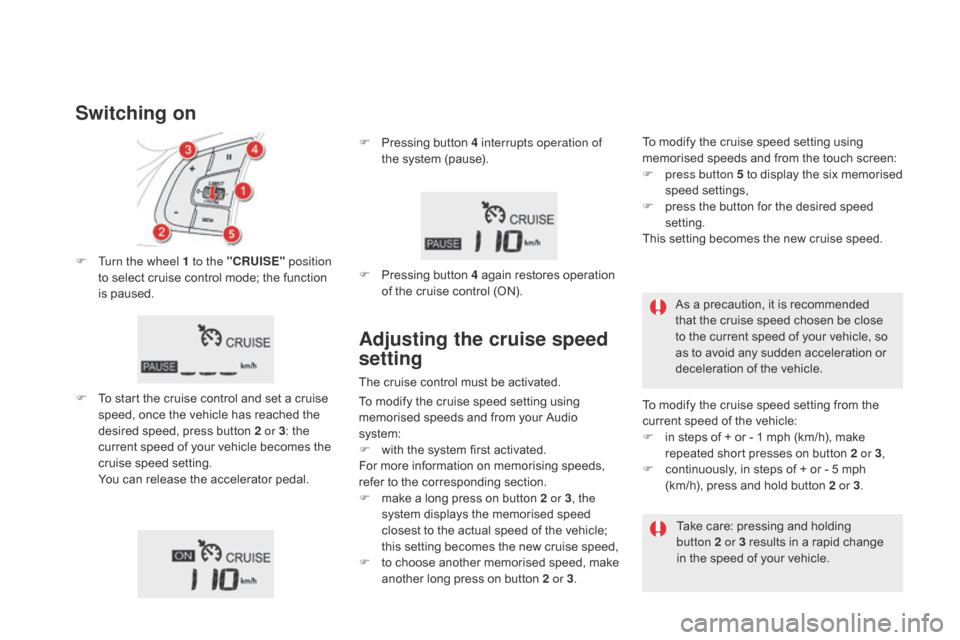
DS5_en_Chap04_conduite_ed02-2015
F Turn the wheel 1 to the "cRUISE" position
to select cruise control mode; the function
is paused.
F
To s
tart the cruise control and set a cruise
speed, once the vehicle has reached the
desired speed, press button 2 or 3 : the
current speed of your vehicle becomes the
cruise speed setting.
Yo
u can release the accelerator pedal.
Switching on
F Pressing button 4 interrupts operation of
the system (pause).
F
Pr
essing button 4 again restores operation
of the cruise control (ON).
Adjusting the cruise speed
setting
The cruise control must be activated. As a precaution, it is recommended
that the cruise speed chosen be close
to the current speed of your vehicle, so
as to avoid any sudden acceleration or
deceleration of the vehicle.
To modify the cruise speed setting from the
current speed of the vehicle:
F
in s
teps of + or - 1 mph (km/h), make
repeated short presses on button 2 or 3 ,
F
co
ntinuously, in steps of + or - 5 mph
(km/h), press and hold button 2 or 3 .
Take care: pressing and holding
button
2
or 3
r
esults in a rapid change
in the speed of your vehicle.
To modify the cruise speed setting using
memorised speeds and from your Audio
system:
F
wi
th the system first activated.
For more information on memorising speeds,
refer to the corresponding section.
F
ma
ke a long press on button 2 or 3 , the
system displays the memorised speed
closest to the actual speed of the vehicle;
this setting becomes the new cruise speed,
F
to c
hoose another memorised speed, make
another long press on button 2 or 3. To modify the cruise speed setting using
memorised speeds and from the touch screen:
F
pr
ess button 5 to display the six memorised
speed settings,
F
pr
ess the button for the desired speed
setting.
This setting becomes the new cruise speed.